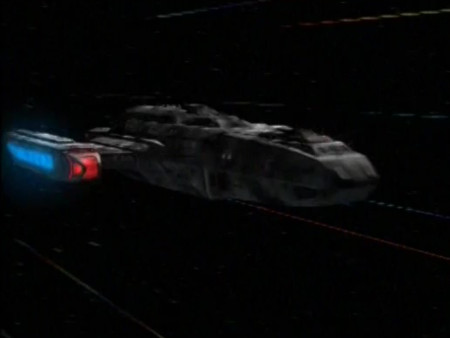Aerie class (LUG)
| Commissioned | 2347 |
| First Appearance | VOY174 (8 Oct 1997) |
| Advertising |
The Aerie class surveyor entered service in 2347 with the commissioning of the S.S. Aerie NAR-32002. A long-range, deep-space scientific explorer, the Aerie class was designed to operate independently for extended periods with a small crew composed of scientific experts. Most Aerie class vessels were made available to civilian scientists through the Federation Science Council.[1]
Four decks in height, the Aerie class could be modified to fulfill a number of mission profiles; for example, berthing and storage facilities could be removed in favor of additional laboratories, but at the cost of reduced mission duration. Unneeded laboratory space could likewise be swapped out for additional cargo modules, extending the ship's mission timeframe. For most mission profiles, the Aerie class could sustain a crew of up to ten, but its sophisticated operations systems allowed it to be run by as few as two people.[1]
In addition to the extensive scientific initiatives undertaken by Starfleet, many more scientists engage in private research under grants provided by the Federation. In order to gather data, conduct experiments, and test their theories, civilian scientists usually would have a starship placed at their disposal, but the demand for access typically far exceeded supply. Even when ships were available, Starfleet could only spare vessels for short periods of time. To address this shortfall, in the mid 24th century the Federation Science Council requested that Starfleet explore a program whereby dedicated science starships could be made available to qualified candidates for a long-term loan.[1]
The result was the Starfleet Joint Research Project. The Corps of Engineers designed and built starships that were compact in design, capable of extended missions, and equipped with enhanced sensor grids and interchangeable laboratory facilities. Starfleet administered the deployment of the fleet for extended, detached missions based on recommendations from the Science Council, and individual scientists and research groups submitted applications to the Federation for the loan of the vessels.[1]
| Date Entered Service | 2347 |
| Length | 90m |
| Height | 20m |
| Beam | 38m |
| Decks | 4 |
| Crew | 2-10 |
| Impulse System | FIG (0.9c) |
| Warp System | LF-10 |
| Cruising Speed | Warp 5 |
| Maximum Speed | Warp 6 |
| Emergency Speed | Warp 8 |
| Landing Capability | Yes |
| Shuttlecraft | None |
| Tractor Beams | 1 fore, 1 aft |
| Transporters | 2 4-person standard |
| Weapons | 2 Type II Phaser arrays 1 Mark 22 torpedo launcher (aft) |
Aerie class vessels
LUG Timeline
U.S.S. Aerie NAR-32002 • U.S.S. Dunnock NAR-32007 • U.S.S. Greenfinch NAR-32335 • U.S.S. Gull NAR-32210 • U.S.S. Linnet NAR-32552 • U.S.S. Raven NAR-32450 • U.S.S. Robin NAR-32048 • U.S.S. Rook NAR-32382 • U.S.S. Skylark NAR-32708 • U.S.S. Starling NAR-32877 • U.S.S. Swift NAR-32410 • U.S.S. Tern NAR-33199 • U.S.S. Warbler NAR-32191 • U.S.S. Wren NAR-32624
Notes and References
- ↑ Jump up to: 1.0 1.1 1.2 1.3 Heinig, Jess Ross A. Isaacs (Line Developers). Starships. Star Trek Roleplaying Game. Book 4. Written by Bill Bridges, Andrew Greenberg, Kenneth Hite, Ross A. Isaacs, and Doug Sun. Illustrations by David Pipgras. Decipher, Inc.. 2003.

